
|
Back to |
| The Front Page |
| The Game |
|
DO's and DON'Ts on artificial turf |
|
by Bob Alman photos by Don Whalen, Karen Connery-Albert, and Bob Kroeger; with special thanks to Don Oakley, Bob Kroeger, and Don Whalen Posted January 12, 2013
|
Sandhill Cove is a retirement community in Palm City, about 30 miles north of the National Croquet Center in West Palm Beach. Shortly after I moved to Florida to organize the Center in 2000, I was invited as a VIP guest to the official opening of a new lawn at Sandhill Cove, complete with a formal dinner with gracious little speeches and a bag-pipe led procession past the sparkling new lawn. The court was perfectly sited on a cove affording a long view of the broad St. Lucie River to the east as it nears the Atlantic. It was an ideal lawn, in both quality and setting. Imagine my surprise, a decade later, when I was told they were replacing the grass with synthetic turf. The search for answers led me to attempt a survey article on the subject which, however, is far from definitive. So there will be a follow up in a year or so, with the help of our readers from around the globe.
Don Whalen is a member of the National Croquet Club who lives about midway between the two facilities and does a weekly Golf Croquet novice program at Sand Hill Cove. When he suggested I might like to see the new artificial surface, he had no idea I was there ten years ago to help the club open their gorgeous new grass court.
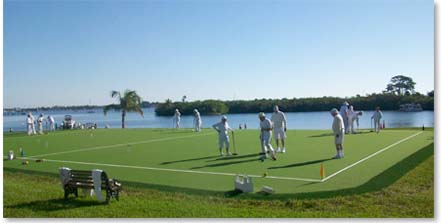
|
| The new artificial surface at Sandhill Cove in Florida, configured for putting, bocce, and croquet, is marked out permanently for half courts; Golf Croquet is the game of choice. |
Their reasons for going artificial were compelling, as it turned out. They had loved the grass court, as had the golf putters and bocce players on their portion of the same lawn. But after a few years, there was a virulent invasion of nematodes. As caretakers of lawns know, there are few permanent solutions for the blight caused by these tiny insects, and because of environmental restrictions, the club undertook, several times, the radical but temporary remedy of entirely replacing the top layer of the lawn where the varmints lived and multiplied and turned to a nauseous yellow the once brilliant green of the turf.
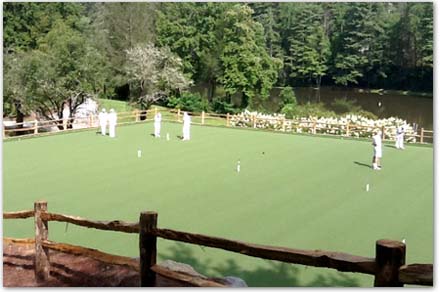
|
| The new court of Cedar Creek Racquet Club in the mountains of Cashiers, North Carolina, is part of the spectacularly rapid growth of USCA croquet at popular summer resorts. |
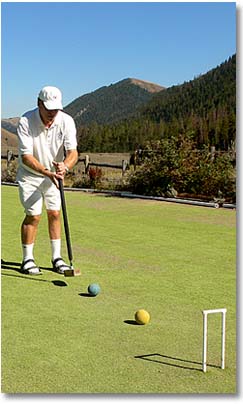
|
| Bob Kroeger tries out a new synthetic turf court on a Wyoming ranch which survives the long and hard winter in great shape. |
So the Sandhill Cove owners and the club decided the only workable solution was artificial turf: just as expensive to install as a grass court, but much less expensive to maintain, over time. (Their annual expense of grass court maintenance--not even counting the periodic replacement of all the grass--was $18,000).
I tried out the lawn on warmish October day, and found it very playable. None of the Sandhill Cove members are highly ranked, and they play mostly Golf Croquet, so the full-size lawn is permanently set up as two half-courts, with permanent white boundary lines.
The stages of construction
The Sandhill Cove Croquet Club is fortunate to have among its members a former Park and Rec Director accustomed to closely examining costs versus benefit. Frank Menagh explained to me how the factors settled out in a lunch overlooking the lawn that included Don Whalen and the Sandhill Cove social director. According to Menagh, "The artificial turf installation cost of approximately $85,000 included the putting green and bocce court, so the price for our croquet court would be about $60,000. That included tearing up the existing court, removing the irrigation system, installing a taller type of artificial grass beyond the boundaries and putting down an artificial turf with an eight-year warranty. They only play Golf Croquet in a limited way here, so I expect that with this type of play, the turf should last several years beyond the warranty period.
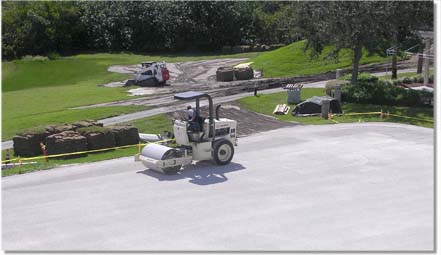
|
| Rolling the rock base at Sandhill Cove was one of the early steps in late September to prepare the new courts for the winter season. |
"The expected payback period is three to four year," Menagh estimates. "I've played on this court all week, and it's fast, but not too fast. You get used to the speed. And the boundary lines are permanent, which is a nice feature."
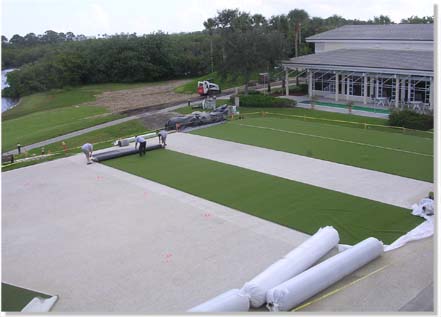
|
| By early October, the completion of the foundation, with layering of several strata of porous rock and sand, anchored by scam cloth, allowed for the final step: putting down the turf. |
According to Jeff Graham, representative of the Florida company who did the installation, "We actually seamed in strips of white artificial turf to create the lines just like we do for football or soccer fields, to make the lines permanent." Jeff's company describes as "unique" their method of accommodating the hoops and the occasional need to remove them.
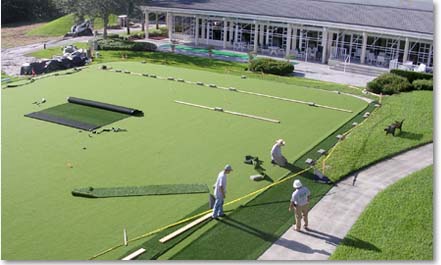
|
| An apron of courser synthetic grass in darker green separates the playing surface from the natural grass surrounding the court, adjacent to the community's dining hall. |
The future will see more artificial courts
Environmental regulation will make the artificial surface increasingly more desirable at many croquet clubs throughout the world--especially in places like Australia, where water management is becoming an increasingly important factor.
Although basic construction methods have not changed much in the last 20 years, the fibers used for artificial surfaces have greatly improved, and court-building consultants on every continent have learned how to install multiple settings for hoops with cushioning to make them more playable and avoid wear patterns. In addition, the best builders (you can find them in Google under "Synthetic Croquet Court") have learned how to build the aggregate base with sufficient porosity and stability to last many years in a variety of climatic conditions, including alternating periods of freeze/thaw and wet/dry.
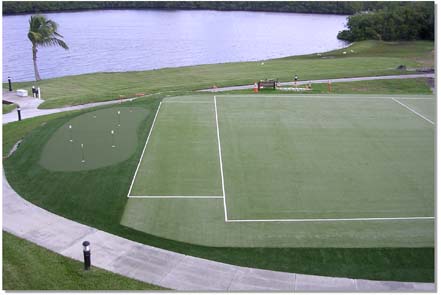
|
| By the second week of October, the new surface was complete and playable, for putting, bocce, and croquet, needing only the official ribbon cutting and opening ceremony. |
Although many if not most of the firms who install artificial grass include "croquet" in their offerings, you should make sure any builder you select knows how to install the kind of surfaces used in our sport, as opposed to casual long-grass for backyard croquet.
For more than two decades, the US Croquet Association has encouraged the construction of artificial courts as part of an overall strategy of supporting the growth of the sport in America, which was not organized until the late 70's. Two decades ago, the USCA's published estimates of the cost of an artificial court varied between $25,000 to $35,000, and the cost has now inflated to about double that amount. But materials and methods have also improved, so the artificial surface is now a better buy than it was two decades ago.
The basic technology has not changed over that time, although the fibers and hoop setting methods definitely have. In the early 90's, the turf could be longer than one inch, while today the recommended length is closer to one-half inch or less. All preferred surfaces for croquet use sand or a similar silicone material to regulate the speed of the court. Sand is applied to regulate the speed of the court and make it possible to maintain a uniform surface with periodic brushing.
| MOST COMMON PROBLEMS WITH ARTIFICIAL COURTS |
|
• Climate-related dimensional instability of the carpet: stretching or bunching caused by alterations in moisture level and temperature, especially in freeze/thaw cycles.
• Ultra Violent breakdown of the turf binding debrillation and fraying, shedding and splitting of the turf; this issue is addressed in the newest generation of high-quality synthetic grass fibers.
• Fungus spots in the spring that need to be cleaned and treated.
• Seam ruptures.
• Chemical leakage (especially lead) in environmentally sensitive situations.
• Excessive heat absorbed and radiated, especially in the tropics or midday, on unshaded lawns.
• Poor drainage--more likely with a concrete base than with the recommended crushed rock base.
• Too fast a playing surface--which can be moderated by altering the amount of sand infill.
• Hoops that are too "stiff" or "dead" because without cushioning they don't duplicate the experience of shooting earthbound hoops.
If these issues are effectively addressed in the chosen methods of construction and materials and in the maintenance of the court, the players will have little cause for complaint. Court owners should request a multi-year written "guarantee" from the builders and suppliers promising no-cost correction.
|
New York attorney Ron Goldfarb installed a half-court at his place on Woodridge Lake in Litchfield County, Connecticut that allowed for plenty of shade (not possible with real grass) and doubled as a party place, covered with a tent. Goldfarb and his wife Arlene enjoyed the 50' by 40' space, shaded with giant hickory trees and fronted by a low stone wall, for more than a decade, as did more than 30 friends and neighbors. "The court only needed a leaf-blower, and in the spring after the winter snows, I had to brush the surface to treat fungus with a Clorox solution," Golffarb said, "but other than that, and adding sand from time to time, it was maintenance-free." For the entire period of 1994 to 2005, the court did not noticeably degrade.
Goldfarb recalls that the surface preparation was especially critical in the "freeze" zone, to allow sufficient porosity in the crushed rock and sand base, three feet deep, to allow sufficient drainage without damaging the court through alternate periods of freezing and thawing. French drains, removal of trees, and other landscape work took his cost for the small court to about $40,000.
The Goldfarb court and the club it spawned led to the building of a full-size court at nearby Weekapaug, Rhode Island, which was used by the club there for more than a decade. Then-president Bob Prosser reported a "very good experience" with the court, even though the Weekapaug Croquet Club has since replaced it with real grass.
"The surface we had for almost ten years was a good one. It was the same as for the tennis courts and a sound choice for a novice club, with huge savings on initial capital outlay, maintenance, weather damage from winters, and the cost of irrigation systems."
When the croquet club and tennis club merged their membership and expenses, they were better able to afford to install and maintain a grass court. By that time, the level of the players had advanced and those who competed at other clubs, with real-grass courts, complained that their artificial court was too fast.
Perhaps the main problem with artificial courts is not their inherent qualities, but the difference players report and complain about between playing on synthetic turf and playing on real grass. So the main development challenge is in making the playing characteristics as similar as possible--the main considerations being speed and hoop action.
Artificial courts threaten joint use for croquet and bowling in Canada
The majority of croquet clubs in Canada operate on lawn bowling surfaces. According to Louis Nel, former president of Croquet Canada, "Some of the bowling clubs acknowledge they exist only because of their shared expenses with croquet."
However, with the decline of lawn bowling and the parallel decline in revenues, a small movement for Canadian lawn bowling towards artificial surfaces threatens the future of croquet in Canada, according to Nel and another former president of Croquet Canada, Ken Shipley. A practical and workable way for the two sports to share an artificial surface has not yet been devised, but Ed Roberts of Attack Croquet has come as close as anyone so far.
Roberts, who installed the hoops at Cedar Creek Racquet Club in North Carolina, has become an acknowledged expert in designing and installing hoops on artificial surfaces. Among the standards Roberts set for his hoops are requiring that they have the same appearance as earth-based hoops and are adjustable without being removed from the surface. Most of all, "they should have a similar reaction to a ball's passage through an earth-bound hoop. And the court owner needs to be able to maintain the cushioning system with readily obtainable materials." Allowances have to be made for "rabbit tracking," and the in-court holding tubes have to be coverable so the court can be used as a multi-use surface, including for lawn bowls.
I proposed to Roberts that sanding would probably work to repair rabbit runs, but he doesn't think that's a sufficient solution. Instead, he adds at least one extra hoop hole next to the major setting, allowing the court to be minutely adjusted. But, he said, rabbit runs should really be much less a problem with the newer, more durable fibers, because they happen when the fibers wear out and break off. "I have not seen this problem since polypro, an olefin based fiber, left the croquet market place." Roberts comments.
The experience should resemble real grass as closely as possible
Croquet companies and installers around the world have learned that some kind of cushioning of the hoops is necessary in order to produce something like the familiar action of the ball traversing a hoop set in the ground.
Canada's Don Oakley is proprietor of the biggest and most respected croquet supplier in America--Oakley Woods or The Croquet Store. Oakley has also been asked to supply hoops for artificial surfaces many times. "The first instance of was Diane Blow's personal lawn in Connecticut," he told me. "In consultation with the turf installer, we tested a few hoop variations and decided on one that played as closely as possible to a conventional hoop. The challenge with artificial surfaces is that hoops can't be reconfigured at will to, say, two half courts or to offset the configuration to account for wear around the hoops. All that needs to be thought out in the planning stage.
The Blow court did not have hoop receptors but instead employed "Foxy" wickets with pointed, narrow-diameter spears that could be pounded through the surface into the crushed stone base and remain fairly stable over time. Since the Blow court was done, a worldwide consensus has emerged on hoop design and placement for artificial surfaces. The standard in 2013 calls for implanted receptors for hoops and some form of cushioning material that allows a hoop stroke to closely resemble the same stroke through an earth-bound hoop.
As Oakley describes it, "Before the final surface is laid down, you can plant receptors into the subsurface to receive the hoops afterward. These receptors, in our hoops, are made from a polyethylene material that maintains a stiff base but it not as unforgiving as concrete or even hardwood blocks."
Another consideration is the hoop opening size. "We overcame this issue by using round receptors with the hole for the hoop being slightly off-center," Oakley says. "By rotating the receptor after installation, the opening can be varied to suit the user's needs."
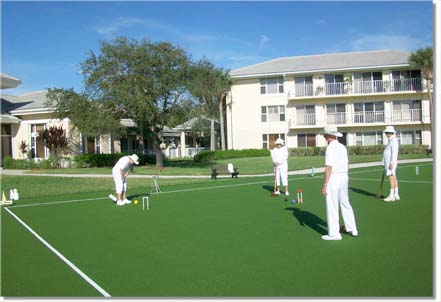
|
| Yellow's partner, though standing directly in the line of play, is not likely to be injured by Red's attempt to save the point at #5. The games are serious but casual at Sandhill Cove, and there's not much hard hitting--so no barrier is needed to protect spectators or players on the other court--or to prevent balls flying into the St. Lucie River. |
As a croquet player, Oakley shares the misgivings of many players who simply prefer the familiar experience of playing on grass. "Playing with Michael Albert on Cedar Creek's newly installed playing surface made me realize how very little attention I've given to walking and playing on natural grass. It's not really something one thinks about, the amount of spring, coolness to the feet, the sound (or lack of it), the smell of cut grass.
"Standing beside the Cedar Creek court, it appears to the casual eye as yet another, perfectly maintained, perfectly level, croquet lawn. The first step, however, brings a new sound and feeds the brain a distinctly different message--with a distinct crunch of stiff plastic bristle-like grass blades. Dropping a few balls on the lawn and hitting them extended that 'sound' experience. I'm not sure if they actually skid more off the face of the mallet as they begin to roll but the sound implies that, especially on harder hits. The sound also continues as the balls roll approximately the same distance as a natural grass lawn.
"The Cedar Creek lawn didn't exhibit any significant bias that draws a ball off its line as it slows--a liability to some artificial surfaces. Roquets and croquets needed some adjusting for the slightly different rolling effect but nothing that couldn't be acclimated to in short order. Hoop running too, was subtly different--especially when played at an angle and gently. In fact, all the playing on this lawn could best be described as 'subtly different.'
Nevertheless, Oakley believes most of the serious issues with artificial turf have been successfully addressed by manufacturers, the best companies installing turf, and croquet professionals who make the hoops and the turf work at an optimal level for the sport. It's just a matter of players adjusting to local conditions, which are the same for everyone. He opines, "I see the use of artificial surfaces only increasing in response to greater restrictions on the use of chemicals and increasing water restrictions."
Roberts agrees with that estimation, and sees additional benefits: "All synthetic courts will be on the fast side, and this is a plus as one may move one- or two-ball combinations from one end to the other end of a court over a wider range of player strength levels. One feels that an extremely slow court is dangerous, especially for beginner and senior players."
Cedar Creek may be the most advanced development model
The mountains of Western North Carolina are the latest and most spectacular new center of growth for USCA croquet in America, with at least eight fairly new croquet facilities already operating and two more being constructed over the winter season. Most of the new courts are real grass, but Cedar Creek went artificial for very compelling environmental reasons.
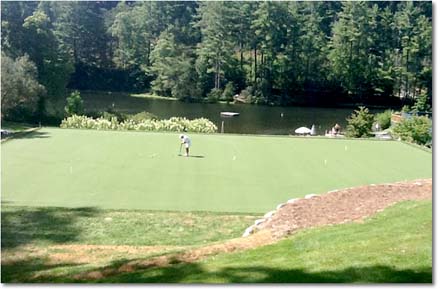
|
| Sometimes the most beautiful settings for new courts argue strongly for artificial surfaces to avoid the environmental issue of chemical runoff into the water supply. |
According to club president Michael Albert, strings are used for the boundaries, allowing shifting at will from half courts to full court. "We have two sets of Ed Roberts' wickets. Each wicket location has three sockets, allowing us to shift the court side to side to avoid rabbit runs. The Attack wickets are cushioned, allowing them to flex a bit preventing rejection normally encountered in artificial surface wickets. The adjustable setting allows me to increase or decrease the clearance as desired. The plugs fit nicely into unused sockets, so the alternate settings are invisible in the turf.
"Our members play Golf Croquet exclusively, but my wife and I also American rules and occasionally invite friends over to join us. It's likely we'll have at least several members learning six-wicket croquet by next year.
"We're very involved with growing the sport in North Carolina and expanding the inter club activities here. We play club-on-club matches weekly, with a grand two-day final championship tournament at the end of the season. I've been chosen to chair that event in 2013."
Albert expects the number of players in the Highlands/Cashiers plateau area to exceed 1200 by the end of summer 2013. In the meantime, his new court, overlooking a major water course, embodies the best and latest of artificial court know-how in America.
In fact, the best advice for anyone considering the artificial alternative is to actually visit the court, play on the surface, and test out the action of the hoops. Most important, don't buy any "promises" of sales reps or contractors that are not made in the form of a timeline with a written guarantee.
READERS: WHAT IS YOUR EXPERIENCE?
This article summarizes the current state of the art in North America, which is reflected in other croquet countries around the world. You can help provide a broader survey of the possibilities, with your self-posted report and comments on our 2013 LETTERS page.